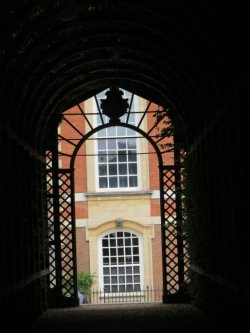 HAMPTON COURT PALACE - London
HAMPTON COURT PALACE - London
Hampton Court Palace is a royal palace in the borough of Richmond upon Thames, 12 miles (19.3 kilometres) south west and upstream of central London on the River Thames. Building of the palace began in 1515 for Cardinal Thomas Wolsey, a favourite of King Henry VIII. In 1529, as Wolsey fell from favour, the cardinal gave the palace to the king to check his disgrace.
The palace went on to become one of Henry's most favoured residences; soon after acquiring the property, he arranged for it to be enlarged so that it might more easily accommodate his sizeable retinue of courtiers. Along with St James' Palace, it is one of only two surviving palaces out of the many the king owned. The palace is currently in the possession of Queen Elizabeth II and the Crown.
In the following century, King William III's massive rebuilding and expansion work, which was intended to rival the Palace of Versailles, destroyed much of the Tudor palace. His work ceased in 1694, leaving the palace in two distinct contrasting architectural styles, domestic Tudor and Baroque. While the palace's styles are an accident of fate, a unity exists due to the use of pink bricks and a symmetrical, if vague, balancing of successive low wings. King George II was the last monarch to reside in the palace.
Today, the palace is open to the public and a major tourist attraction, easily reached by train from Waterloo station in central London and served by Hampton Court railway station in East Molesey, in Transport for London's Zone 6. In addition, London Buses routes 111, 216, 411 and R68 stop outside the palace gates. The structure and grounds are cared for by an independent charity, Historic Royal Palaces, which receives no funding from the Government or the Crown. In addition, the palace displays many works of art from the Royal Collection.
Apart from the Palace itself and its gardens, other points of interest for visitors include the celebrated maze, the historic royal tennis court (see below), and the huge grape vine, the largest in the world as of 2005. The palace's Home Park is the site of the annual Hampton Court Palace Festival and Hampton Court Palace Flower Show.
Tudor times
Thomas Wolsey, Archbishop of York, chief minister to and favourite of Henry VIII, took over the site of Hampton Court Palace in 1514. It had previously been a property of the Order of St John of Jerusalem. Over the following seven years, Wolsey spent lavishly (200,000 Crowns) to build the finest palace in England at Hampton Court. Today, little of Wolsey's building work remains unchanged. The first courtyard, the Base Court, was his creation, as was the second, inner gatehouse which leads to the Clock Court (Wolsey's seal remains visible over the entrance arch of the clock tower which contained his private rooms (O on plan). The Base Court contained forty-four lodgings reserved for guests, while the second court (today, Clock Court) contained the very best rooms – the state apartments – reserved for the King and his family. Henry VIII stayed in the state apartments as Wolsey's guest immediately after their completion in 1525.
Click Picture to Zoom
 HAMPTON COURT PALACE - London
HAMPTON COURT PALACE - London









